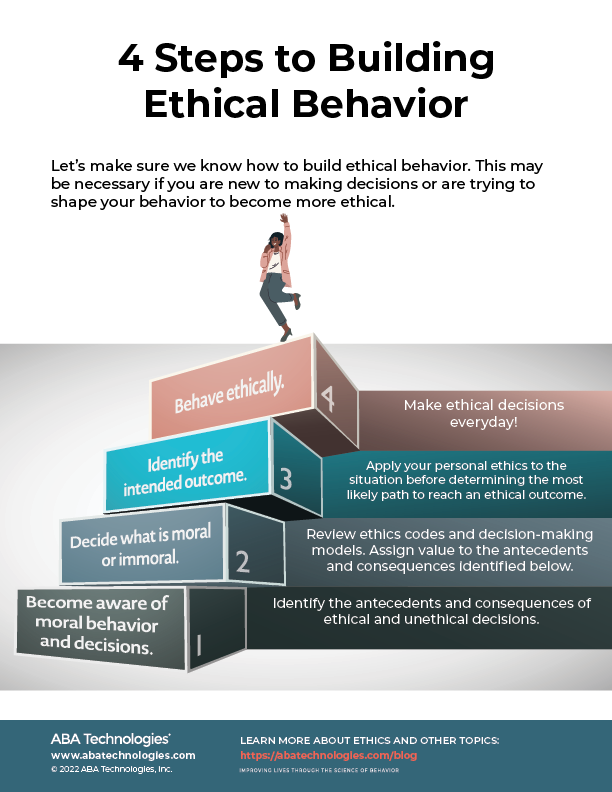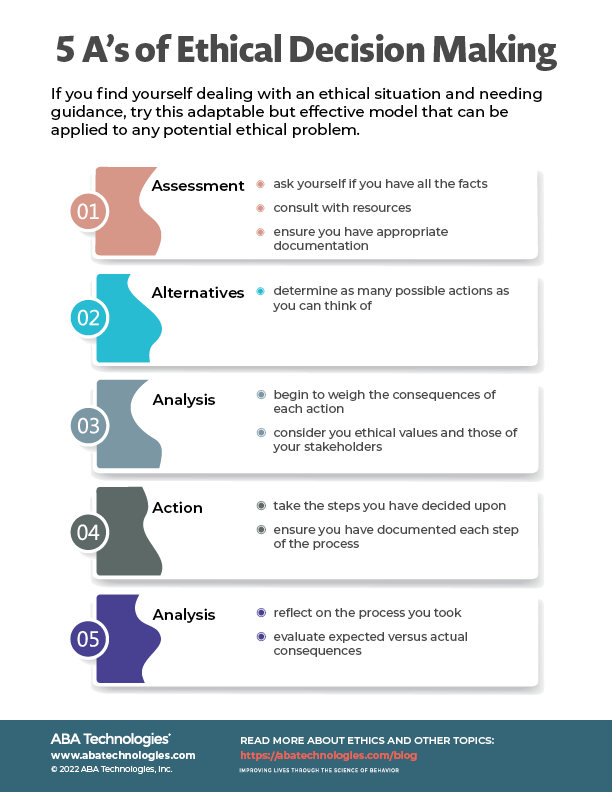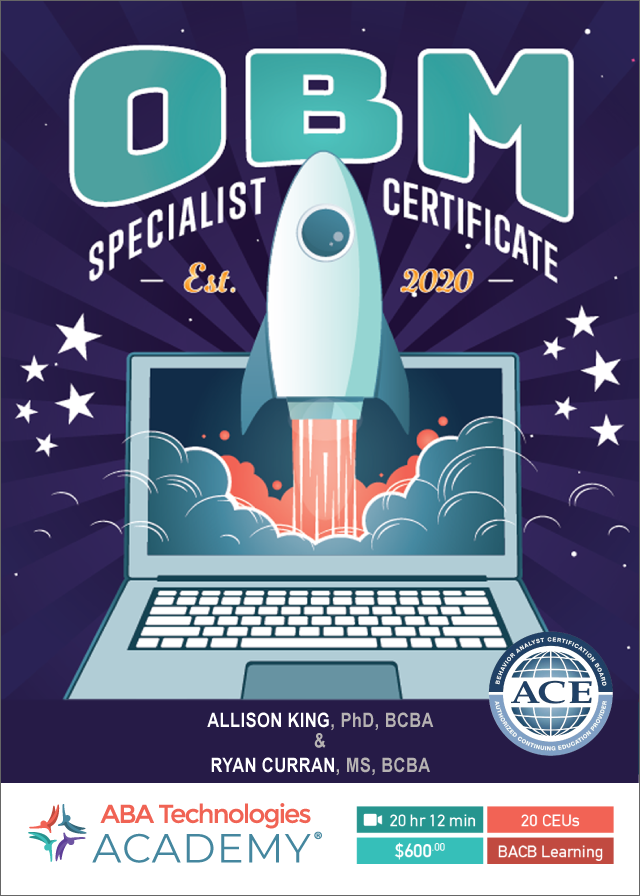
How Do Ethics Apply to OBM
Author: Maddie Duke, MS, BCBA
Over the past year or so, the Journal of Organizational Behavior Management (JOBM) has published discussion articles revolving around ethics, licensure, and certification in OBM. One discussion argued for the use of licensure and certification as a way to manage the ethical behavior of OBMers, where others said that OBMers can monitor their own behavior. Another point made fell in between, saying that OBMers might seek certifications that benefit them but should not be required to do anything that doesn’t further their career.
Licensure and OBM
Weatherly wrote, "although certification is a voluntary process, licensure is not." This isn’t usually true for an OBMer unless they bill insurance companies for their services. All BCBAs should be aware of the licensing laws in their states, looking specifically at the definitions of behavior analyst in the licensing law. If organizational consulting is mentioned, as in Missouri and Kentucky, licensure may be necessary. For states that do not include consulting in their definition of behavior analyst, licensure is likely unnecessary.
Certification and OBM
Currently, the closest thing to an OBM-specific certification is the OBM Specialist Course, offered by ABA Technologies, Inc. This certification counts as 21 continuing-education credits with the BACB, though not all OBMers seek continuing education because they need to fulfill certification requirements. In fact, many OBMers do not obtain or maintain current certifications through the BACB, even if they have met most of the certification exam requirements. Why is this? Well, other fields have a lot to offer, and an OBMer may benefit from the ability to draw from various knowledge bases. For example, an OBMer who focuses on Behavior-Based Safety could look to the Board of Certified Safety Professionals to obtain education and certification related to safety. Someone looking for more information on project management may go to the Project Management Institute. A quick Google search will turn up even more opportunities for continuing education in Lean Six Sigma, consulting, and more.
Are There Even Benefits to These Certifications?
More often than not, certifications require the investment of time and money. How do we evaluate whether these investments are worth it? Let’s first consider the clients that an OBMer is working with. Cloyd Hyten, a consultant for Aubrey Daniels International, said that the most important thing to private sector clients is results. So, if certification will improve the results you can give to your clients, it might be worth it. If not, let’s consider another reason for certifications before we shoot them down entirely. Another benefit offered by certifications is ethical standards.
Some certification boards, including the BACB, hold their certificants to a certain standard of ethical behavior. The BACB provides an ethics code and an avenue to report unethical behavior and requires continuing education in ethics (and other areas). Some others, like the Project Management Institute, have an ethics code but do not require continuing education or provide a way for clients to report unethical behavior. As behavior analysts or behavior enthusiasts, we can evaluate these approaches to ethical behavior.
There are two main ways to promote certain behaviors: antecedents or consequences. The BACB uses both antecedents (through the Ethics Code) and consequences (through the ability to report unethical behavior and potential consequences resulting from such a report) interventions to promote ethical behavior from its certificants. The Project Management Institute uses antecedents alone to encourage the ethical behavior of its certificants.
We know that consequences are more powerful in changing behavior, but antecedents can be effective ways to maintain behavior. Another more complex way to change behavior is through rules. I like to think of ethics codes as a combination of antecedents and rules. Rules are highly effective, while antecedents are less-restrictive interventions than consequences. Our science encourages using the least-restrictive method likely to be effective at whatever we do. Since there is currently no evidence of widespread ethical problems in the field of OBM, antecedent strategies, like ethics codes, are the best way for us to ensure that ethical problems don’t start popping up.
We have already mentioned the BACB code. This may be most applicable for clinical staff, meaning it might not apply to all OBMers. There are also safety, project management, and Lean Six Sigma ethics codes. There is even an ethics code specific to consultants. OBMers can look to any of these or others to determine their ethical standards. However, ethics codes are not the only option to promote ethics.
Building Ethical Behavior
Before we get into other antecedent strategies, let’s make sure we know how to build ethical behavior. This may be necessary if you are new to making decisions or are trying to shape your behavior to become more ethical. How can you do this? Mark Schwartz is a professor of business ethics, and he has actually developed a model for developing ethical behavior!
First, we need to become aware of moral behavior and decisions. This will include evaluating your environment to identify the antecedents and consequences involved in the ethical or unethical decisions you make. Remember, identifying antecedents and consequences does not involve placing judgment on those variables—we are simply identifying them.
The next step is called moral judgment, which is where you decide what you believe is moral or immoral. This is a great step to review ethics codes, decision-making models and read things (like this article) that help define ethical and unethical behavior. This is also the step where we assign value to different environmental variables and determine whether or not they fit with the most ethical decisions in our daily practice.
Moral intention is next, and this has to do with the function of your behavior. What is the outcome you are hoping to achieve by making this decision?
Finally comes moral behavior—actually behaving in an ethical way.

Other Antecedent Strategies
Another way to ensure ethical behavior may be to incorporate ethical decision-making models into your OBM practice. This model type tends to be less specific and prescriptive than ethics codes. Rather than providing boundaries for ethical behavior, these models provide a framework for everyday decisions. Decision-making models should not be used to develop ethical values and perspectives but can be used in combination with identified values regarding ethical behavior. By following a process or series of steps when making decisions in your OBM practice, you can build the skill of ethical decision-making.
One model is found in the BACB Code of Ethics. Unsurprisingly, the language and suggestions are very clinical. It might be a good place to start if you are already familiar with the code, even if you are working outside the clinical realm. Ethical Decision Making in the Workplace was written by an OBMer. Still, some of the recommendations are focused on leadership, meaning they may or may not apply to all OBMers.
If you find yourself dealing with an ethical situation and needing guidance, I personally love combining some aspects of the BACB’s decision-making model with the Project Management Institute. The PMI model is simple, with just a few steps that should resonate with behavior analysts and OBMers everywhere. The BACB has a longer model that breaks down more steps that should be taken. By combining these two models with some of my own ideas, I think we can develop an adaptable but effective model that can be applied to any potential ethical problem.
- Assessment
- Ask yourself whether you have all the facts about the situation, your own ethical values, and personal biases you may have.
- Consult with various resources, including ethics codes and decision-making models.
- Ensure you have appropriate documentation.
- Alternatives
- Determine as many possible actions as you can think of.
- Analysis
- Begin to weigh the consequences of each action. How would they affect the client and stakeholders? Do these actions and consequences align with your ethical values?
- Remember to consider the ethical values of your stakeholders, paying careful attention to any contracts you may have signed with an involved organization.
- Action
- Take the steps you have decided upon. Ensure you have documented each step in this process.
- Analysis (again)
- This is my addition to the process. Reflect on the process you took to make an ethical decision. Did it work for you? Would you change any of the steps you took? Did the expected and actual consequences match? Why or why not? This reflection is personal feedback that will improve your next ethical performance.

Let’s practice using this decision-making model. Let’s say that you, an external consultant, discover a billing oversight that resulted in billing a client for 10 hours over what you worked.
- Assessment: In this situation, a mistyped number led to overbilling. Reviewing the consultant ethics code shows that one code is to do no harm to the client. Paying for services not received may put the client in a difficult financial situation. However, perhaps you have not yet obtained another consulting contract and are concerned about your own personal financial situation. This would be a personal bias that you need to remain aware of during this scenario.
- Alternatives: There seem to be three options here: You could contact the client to correct the overbilling, say nothing, or you could try to provide ten more hours of service.
- Analysis: Contacting the client to correct the situation would likely make you feel uncomfortable. You may be subject to reprimands, criticism, or even loss of future business opportunities. When you review the contract, you signed with the organization; you see a statement that overbilling will lead to a $10,000 fine and possible prosecution. Hopefully, you will avoid the fine by correcting the issue, but you can’t be sure. Saying nothing could result in the same reprimand, criticism, and loss of business, but only if someone finds out. Even if someone finds the error, you may be able to claim that you did not know until they pointed it out. If you try to provide more services for the client, you may or may not be able to reach the full 10 hours without someone noticing that you are not billing for more time. If this question came up, you could again be subject to reprimands, criticism, or loss of business. On the other hand, someone may see your additional services as going above and beyond and be impressed that you are following up so thoroughly.
- Action: After reviewing all of the alternatives, you decide to contact the organization to correct the bill. This best fits your value of honesty, follows the code of ethics you prescribe, and allows you to fulfill the contract you signed.
- Analysis: When you contact the organization, they thank you for reaching out. They state that they understand that mistakes happen, and the mistake is corrected. There is some mild criticism and a reminder to double-check bills before sending them to a client, but you are told that the organization was pleased overall with your services and that they would consider hiring you in the future.
Now it is your turn to practice making an ethical decision using another scenario.
This time let’s say that you are working as a project manager. You oversee a team of employees and report to an organization executive. While walking to the break room one day, you overhear an employee from another department making sexual comments to one of your employees. You walk into the break room, and both employees quickly leave the room to return to their desks. What is the most ethical course of action to take?
- Assessment:
- Alternatives:
- Analysis:
- Action:
- Analysis:
My first step was to consult with the relevant people, which for me would be my employee and the organization executive (assessment). After thinking through the different courses of action (alternatives), I examined the expected consequences of calling a meeting with the employee from the other department (analysis). Would this communicate to the employee that their actions were unacceptable, or would I need to involve their personal supervisor? How would this affect my employee’s comfort in the workplace? I decided to meet individually with the employee from the other department, followed by an email addressed to the employee and their immediate supervisor (action). After taking this action, I will set aside time to review the effects of my decisions (analysis).
Can you think of a situation you have personally encountered that could have been solved with these same steps? Practice thinking through that situation and determine what decision should be made.
- Assessment:
- Alternatives:
- Analysis:
- Action:
- Analysis:
Hopefully, you were able to see that ethical situations can be complex and challenging but that it is beneficial to be familiar with a variety of resources to make the best ethical decisions possible. It is even more beneficial to practice making ethical decisions. Doing so is like a muscle that gets stronger the more you use it. Regardless of your licensure or certification, you can access a plethora of available resources that will help you act ethically. While this process of determining ethics and evaluating values may take more effort than simply subscribing to a particular ethics code or latching onto a single organization to manage your ethical behavior, the effort is well worth it.
References
- Weatherly, N. L. (2021). The ethics of organizational behavior management. Journal of Organizational Behavior Management, 41(3), 197-214, DOI: 10.1080/01608061.2021.1890664. https://www-tandfonline-com.portal.lib.fit.edu/doi/pdf/10.1080/01608061.2021.1890664
- Behavior Analyst Certification Board. (2020). Ethics code for behavior analysts. Littleton, CO: Author. https://www.bacb.com/wp-content/uploads/2022/01/Ethics-Code-for-Behavior-Analysts-220316-2.pdf
- https://www.michigan.gov/lara/bureau-list/bpl/complaint/health/what-happens-after-a-complaint-is-filed
- https://www.bacb.com/wp-content/uploads/2022/01/BACB-Code-Enforcement-P…
- Wine, B. (2021). More musings on ethics: a response to Weatherly (2021). Journal of Organizational Behavior Management, DOI: 10.1080/01608061.2021.1957744. https://www-tandfonline-com.portal.lib.fit.edu/doi/pdf/10.1080/01608061.2021.1957744
- McSween, T. (2022). Reflections on ethics and licensure in OBM. Journal of Organizational Behavior Management, DOI: 1080/01608061.2022.2032532. https://www-tandfonline-com.portal.lib.fit.edu/doi/pdf/10.1080/01608061.2022.2032532
- Hyten, C. (2022). On ethics codes, licensure, and OBM. Journal of Organizational Behavior Management, DOI: 10.1080/01608061.2022.2027320. https://www-tandfonline-com.portal.lib.fit.edu/doi/pdf/10.1080/01608061.2022.2027320
- https://www.bcsp.org/wp-content/uploads/2021/11/BCSPcodeofethics.pdf
- https://www.pmi.org/about/ethics/code
- https://abatechnologies.com/professional-development/obm-specialist-certificate
- https://www.bcsp.org/certified-safety-professional-csp/
- https://www.pmi.org/certifications
- https://www.zenagile.com/agile-training/
- https://www.aubreydaniels.com/media-center/ethical-decision-making-workplace
- https://managementhelp.org/misc/ethical-consulting.pdf
Schwartz, M. S. (2017). Teaching behavioral ethics: overcoming the key impediments to ethical behavior. Journal of Management Education, 41(4), 497-513. https://journals-sagepub-com.portal.lib.fit.edu/doi/pdf/10.1177/1052562…;
OBM Specialist
We highly recommend the OBM Certificate series to anyone interested in gaining education and experience in OBM, whether they want to apply it in their current professional role or transition into an OBM-related role.










